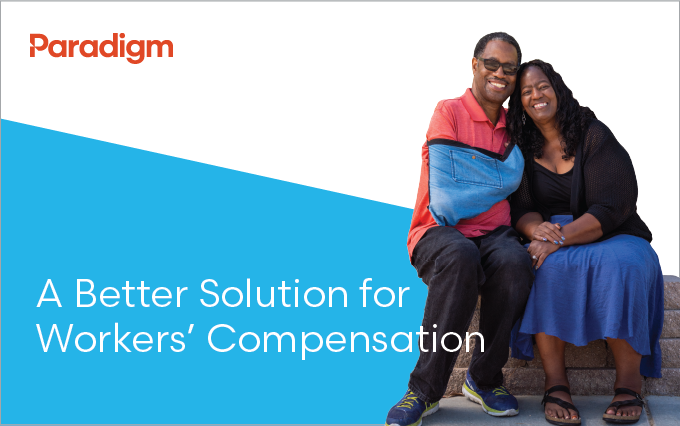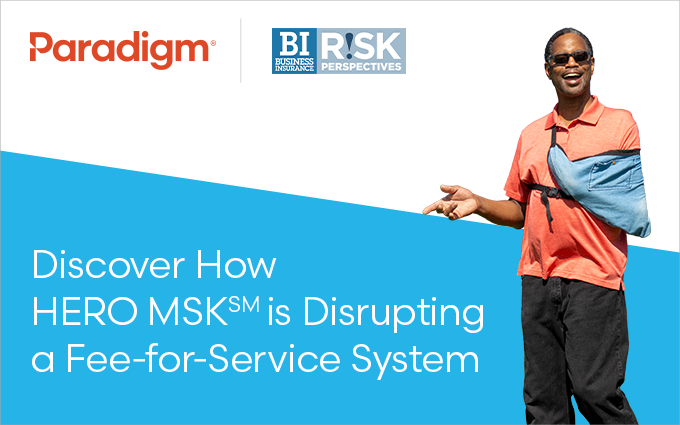04/04/2024

Three perspectives from Paradigm leaders explore how guaranteed outcomes, increased patient engagement, and aligned incentives can create a better system for everyone—including those who experience, treat, and pay for musculoskeletal (MSK) injuries.

From the start, the workers’ compensation system has been built on a fee-for-service model where providers bill for activities of care they perform. While sending a bill for performing a service seems like a straightforward way to reimburse for the practice of medicine, it can lead to mis-incentives that don’t always align with helping injured workers’ timely recovery and return to prior level of function. The main problem is that this model focuses simply on activities—not outcomes.
In the current system, a worker with a knee or back injury typically sees a doctor, receives diagnostic imaging, and gets prescriptions for medications, along with some outpatient physical therapies. If symptoms do not improve, the injured worker will be referred to specialists for additional expert recommendations. This may lead to surgical and interventional procedures, which will be followed by more prescriptions and additional physical therapy and rehabilitation. This cycle can be repeated ad nauseam if symptoms persist. Although the sequence of these activities initially appears reasonable, the reality is there is a lack of accountability to the goal of returning the injured worker back to work and functional health.
All of these care services can be successfully performed, billed, and reimbursed without necessarily resulting in an optimal outcome for the injured worker. When the entire system is built around payment for activities, providers spend a disproportionate amount of time performing activities and documenting these treatment activities for reimbursement. The focus is not always on providing the high-value aspects of care that contribute to achieving functional recovery to return to work.
This conundrum is further complicated by the traditional approach to creating provider networks. Currently, provider networks are created with attention to negotiated savings for provider services. Many networks base discounts on the number of patients they send to a provider. While volume-based discounts are effective in other areas of business, this can create challenges in health care.
Whether a provider sees 10 injured workers or 10,000, the time that should be spent on each case doesn’t decrease relative to the referral source. Medical errors, low-value treatment, and missed or incorrect diagnoses certainly aren’t reduced by volume or discounts—and this can escalate the total cost of care.
The result of this activity-based model is extreme frustration for our health care industry, including workers’ compensation stakeholders. Too often, providers are overwhelmed as they spend less time with more patients—while patients become disengaged as the quality of interaction and overall care decreases. Instead of focusing on practicing high-value health care, physicians and clinicians are required to spend more time on billable activities and meeting patient quotas.
I’ve been an advocate for value-based, outcome-focused care since its inception in 2010 with the introduction of the Affordable Care Act. In fact, Paradigm’s commitment to this value-based model and proven results is one of the reasons I joined this organization more than 10 years ago. In value-based, outcome-focused care, the goal is to align incentives around achieving measurable outcomes and becoming accountable to the cost of care spent for the health of injured workers. This enables a more appropriate competitive market; one that is centered on achieving better outcomes at better value for episodes of care related to a given medical condition or injury diagnosis.
Aligning care around outcomes is a necessity for a value-based reimbursement methodology to improve our health care system and workers’ compensation claims management. As we’ll see next, focusing on outcomes naturally moves the care upstream to address the identification and mitigation of risks, such as costly comorbidities and behavioral health issues.

For too long, the norm in workers’ compensation has been to avoid mental and behavioral health diagnoses due to their open-ended nature and the ongoing costs of a compensable mental health claim. This has created an environment where unaddressed behavioral concerns can have a negative impact on physical recovery, potentially creating a downward cycle of worsening physical and mental health. Although the intention is to limit spending, the effect often increases the length and cost of claims.
There’s a famous quote from Archbishop Desmond Tutu, “There comes a point where we need to stop just pulling people out of the river. We need to go upstream and find out why they’re falling in.” In health care and workers’ compensation, this speaks to the critical need for preventative care. In the case of work-related behavioral and mental health concerns, addressing underlying risk factors early can prevent a compensable mental health claim later.
For psychosocial issues related to workplace injury, there is considerable evidence that prevention is effective. A 2023 white paper1 demonstrated that surgical outcomes for back-related workplace injury cases tend to be significantly worse than similar cases in commercial health, despite workers’ compensation patients being statistically younger and healthier. The paper highlighted psychosocial risk factors as primary drivers of poor outcomes and increased costs.
In workers’ compensation, there are many risk factors that can be successfully addressed early and sub-clinically, including perceived injustice, symptom magnification, and fear avoidance behaviors. With proper training and resources, case managers and even claims professionals can engage and empathize with injured workers to build trusting, productive relationships. Combined with ongoing self-guided education, this can create a cognitive shift that helps lessen the risk of a compensable behavioral health diagnosis and long-term, creeping catastrophic loss.
Prior to Paradigm, I served as the Director of Quality at one of the largest physician-owned orthopedic groups in the United States, where I implemented a successful bundled payment for care improvement program and accountable care organization contracts at large health systems. I saw firsthand how an emphasis on whole-person health and outcomes and value-based care models is a significant driver toward proactive care that identifies emerging problems upstream. In the next section, we’ll question how competing interests and disparate incentives within a system can align to build a care platform that truly benefits all participants.

The current fee-for-service model not only incentivizes activity, as Dr. Choo discussed above, but sets stakeholders against each other in counterproductive ways. In addition to networks generating revenue based on discounts, ancillary services like physical therapy, durable medical equipment, and pharmacy managers make money on the spread between wholesale and retail pricing. This creates a financial incentive to focus on the lowest unit cost to help improve the margin between the wholesale and retail price points, versus a focus on reduction in the cost of the episode of care. At the same time, regulations in many states micromanage provider decisions with prior authorizations, formularies, and mandatory forms.
Even if intended to prevent fraud, waste, and abuse, these measures can create downward pressure on quality care decisions. In short, adversarial friction permeates our industry as stakeholders work against each other, often hindering the provision of quality care for injured workers. In fact, allocated loss adjustment expenses, such as bill review and utilization review, can amount to as much as 15% of all medical expenses—and that is before adding the administrative costs of the pharmacy benefit manager, physical therapy networks, and durable medical equipment.
A value-based care model has the power to align incentives around injured worker outcomes. The creation of a single bill for a single episode of care requires everyone to work together and overcome embedded frictional management costs. Instead of focusing on unit price, accountable care organizations compete around total value creation. And providers that truly perform care that achieves better outcomes are rewarded through value-based contracting, even if they perform fewer interventions.
At Paradigm, we have been delivering value-based care to catastrophically injured workers for more than 30 years and have committed to applying that expertise to work-related musculoskeletal injuries. With these conditions comprising a significant portion of workplace injuries, Paradigm’s HERO MSKSM solution provides a much-needed episodic approach to this segment.
HERO MSK delivers access to quality providers who are accountable, value-based partners with a track record for successful outcomes. Paradigm’s predictive analytics and the industry standard for behavioral support move care upstream. Finally, guaranteed outcomes, medical risk transfer, and fixed costs align incentives to build a team around what matters most—injured workers.
Learn more about HERO MSK and value-based care for musculoskeletal injuries.
1 “Is Workers’ Compensation Driving an Epidemic of Healthcare Outcomes Disparity?”; Gerry Stanley, M.D., P-CEO; Adam Seidner, M.D., M.P.H.; 2023; The Hartford.
___________________________________________________________________________
Read more about Paradigm’s HERO MSK

Value-Based Treatment Moves Care Upstream for Better Outcomes
A Q&A with David Lupinsky, Vice President of Clinical Product Solutions

A Value-Based Solution to Disrupt a Fee-for-Service System